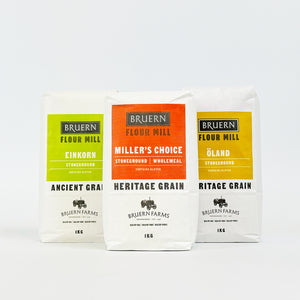
Ancient Grain Flour - Spelt, Rye, Einkorn & More.
Ancient grains have been gaining popularity in recent years due to their nutritional benefits and unique flavors. One way to incorporate these grains into your diet is by using ancient grain flour. But what exactly is ancient grain flour, and what are the different types available? In this blog post, we will explore the world of ancient grain flour and its various varieties.
What is Ancient Grain Flour?
Ancient grain flour is made from grains that have remained largely unchanged for thousands of years. These grains have not been genetically modified or hybridized like modern grains. They are often considered more nutritious and easier to digest compared to their modern counterparts.
Types of Ancient Grain Flour
1. Spelt Flour: Spelt is an ancient grain that has a nutty flavor and a slightly sweet taste. It is rich in protein, fiber, and minerals like manganese and phosphorus. Spelt flour can be used as a substitute for wheat flour in baking.
2. Rye Flour: Rye flour is a type of flour made from ground rye grain. Rye is a cereal grain that is closely related to wheat and barley. Rye flour is known for its distinctive flavor, darker color, and denser texture compared to wheat flour. It is commonly used in various culinary applications, particularly in the baking of bread and other baked goods.
3. Einkorn Flour: Einkorn is one of the oldest cultivated grains in the world. It has a rich, buttery flavor and a higher protein content compared to modern wheat. Einkorn flour is ideal for making bread, pasta, and pastries.
4. Kamut Flour: Kamut, also known as Khorasan wheat, is an ancient grain with a buttery, nutty flavor. It is high in protein, minerals, and antioxidants. Kamut flour can be used in a variety of baked goods, including bread, cookies, and pancakes.
5. Amaranth Flour: Amaranth is a gluten-free ancient grain that is rich in protein, fiber, and micronutrients. Amaranth flour has a slightly sweet, earthy flavor and is often used in gluten-free baking.
6. Quinoa Flour: Quinoa is technically a seed, but it is often classified as an ancient grain. Quinoa flour is gluten-free and has a mild, nutty flavor. It is a great option for gluten-free baking and can be used in a variety of recipes.
Benefits of Ancient Grain Flour
Ancient grain flours offer several benefits:
- They are often higher in protein and fiber compared to modern grain flours.
- They contain a variety of vitamins, minerals, and antioxidants.
- They have a unique flavor profile that can enhance the taste of baked goods.
- They are generally easier to digest for individuals with gluten sensitivities.
How to Use Ancient Grain Flour
Ancient grain flours can be used as a substitute for regular flour in a variety of recipes. However, it's important to note that ancient grain flours have different properties compared to traditional flours, so some adjustments may be necessary. Here are a few tips:
- Start by substituting a portion of the regular flour with ancient grain flour and gradually increase the ratio as you become more familiar with the flavor and texture.
- Experiment with different combinations of ancient grain flours to create unique flavors and textures in your baked goods.
- Consider using a recipe specifically designed for ancient grain flours to ensure the best results.
Now that you have a better understanding of ancient grain flour and its various types, you can explore the world of ancient grains and incorporate them into your cooking and baking adventures. Enjoy the nutritional benefits and unique flavors that ancient grain flours have to offer!





Leave a comment